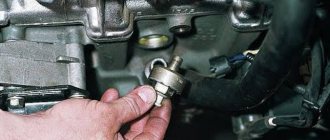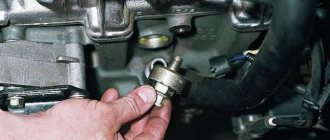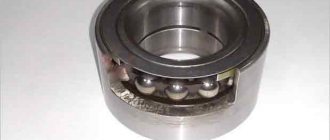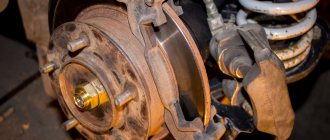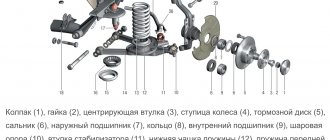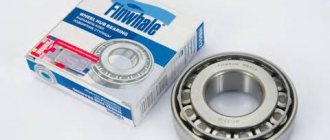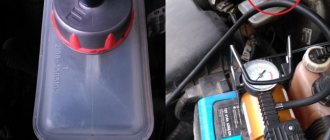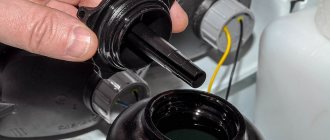In 2002, GM-AvtoVAZ began serial production of the Chevrolet Niva. This model has retained all the advantages of the old Niva - the presence of permanent all-wheel drive, a locked center differential, as well as a two-speed manual gearbox.
Chevrolet Niva has 6 trim levels, namely: L, LC, LE, GL, GLC and LE+. The last of them was presented in 2015. It differs from the rest in the presence of air conditioning, a full safety package, Continental Cross Contact tires, K&K “Camelot” wheels, special rear bumper protection, a towbar, as well as unpainted moldings.
To make driving easier, the manufacturer equipped the car with hydraulic power steering (power steering).
Let's look at what fluids are used in power steering Niva Chevrolet, how to check the oil level and replace it yourself.
Types of power steering fluids for Chevrolet Niva
The original working fluid for power steering Niva Chevrolet is Pentosin CHF 11S.
Among its analogues we can note PSF, which has almost the same characteristics, but at a more reasonable price. Pentosin is green, PSF is red or yellow.
In addition to the mentioned oils, it is worth highlighting Mannol Dexron III. This fluid is multi-purpose - it can be used not only in power steering, but also in automatic transmissions, clutches, and other similar mechanisms. Dextron has good low-temperature and antioxidant properties and an increased service life.
Reservoir for windshield and brake fluid.
Page 62
Another filling capacity of the Chevrolet Niva is two glass washer reservoirs, the capacity of which is five and two liters.
Also interesting: How to make a transfer case subframe for a Niva with your own hands
This model has two independent braking systems. The working one has a hydraulic drive, the parking one has a mechanical drive. The contours are separated from each other.
The hydraulic drive includes a special tank made for brake fluid.
- DOT-4 brake fluid is suitable for half-liter hydraulic brakes. The product has improved characteristics and has a boiling point of over 235 degrees. Well suited for regions with low ambient temperatures.
- SAEJ1703, FMSS116 are used for the entire hydraulic system and clutch release (0.15 l). The synthetic product provides good lubrication and reduces oxidation at high temperatures.
- The tank lid hatch hinges, door and hood locks require VTV-1 and FIOL-1 greases. Hinges of steering rods and cardan shafts - ShRB-4, Litin 2, Esma.
- The air conditioner also has two tanks. One of them is for oil (0.22 l), the other is for refrigerant (0.650 kg).
Chevrolet Niva reservoirs for refilling liquids and lubricants are quite reliable and convenient when you need to make a replacement.
Various tags and sensors make it possible to carry out control almost immediately, which allows you to avoid an emergency situation.
Frequency of power steering fluid replacement
It is believed that the oil that was filled into the power steering of a Chevrolet Niva does not require replacement throughout the entire life of the vehicle. However, if there is damage to the steering rack, various contaminants may enter the system.
Over time, the fluid forms sediment, which affects its quality; the temperature difference between winter and summer also negatively affects the condition of the oil in the power steering. This is why it needs to be replaced approximately every six years, regardless of condition.
The design of the Niva Chevrolet steering linkage and its features
The Chevy Niva steering linkage is a movable structure of interconnected elements. The main components are:
- Bipod;
- Pendulum arm (steering pendulum);
- Medium thrust;
- Lateral thrust (right and left);
- Steering knuckles.
A bipod is nothing more than an all-metal lever that is mounted on the steering shaft. The left tie rod is pivotally attached to the end of the lever. The middle link serves to transfer force to the right wheel.
For it, the second support point is the steering pendulum, movably mounted in a special bracket. This pendulum plays the role of a second lever, transmitting force to the right steering rod. Steering knuckles do not belong to the trapezoid, but are often considered as part of the steering system and allow a more detailed description of the process of driving a car.
On Shevik, the side rods consist of two parts. They are connected to each other by a split coupling, which has internal left and right threads on different sides. When the clutch rotates, both parts of the side rod converge or diverge, changing the distance from the bipod or pendulum to the steering knuckle. Thus, it is possible to set a certain wheel toe angle. Typically, the part of the side rod that faces the wheel is called the tie rod end.
Absolutely all Niva Chevrolet trapezoid rods have hinges at the ends. The hinge pins are designed for a conical fit and are tightened with nuts when connected. Hinges allow the trapezoid parts to remain movable relative to each other and relative to the car body. Some car enthusiasts are inclined to believe that the elements of the Shevik steering linkage are suitable for the classic Niva and vice versa.
To describe the operation of the entire vehicle control system, it is enough to indicate the main directions of force transmission from the steering wheel. By means of a worm gear, the rotation of the shaft with a gain in force is converted into rotation of the steering bipod. It is simultaneously connected to the left and middle rods. An analogue of a bipod is a pendulum that can rotate freely in the bracket.
When a car turns, the wheels describe a circle of different radii. Provided that the angular velocity on the axle is the same, one wheel will certainly slip. This leads to increased tire wear and poor handling. The solution to the problem comes down to the fact that during a maneuver the steering knuckles must turn at different angles relative to the straight line of motion of the car.
This ratio can be ensured by correct selection of the inclination of the levers, as well as their length. If it is not possible to completely eliminate slipping, then it is necessary to reduce it to a minimum. The wheel alignment angle must be adjusted after any repair work on the trapezoid. It is especially often necessary to change the steering tip, and it is recommended to replace it on both sides at once.
Also interesting: Front suspension Niva 2121, Niva 2131
Features of operating a Chevrolet Niva car affect the condition of the trapezium elements, so it is important to periodically carry out diagnostics. In order not to lead to the failure of the linkage joints, it is necessary to check the integrity of the protective covers. During the inspection, attention is paid to the presence of cotter pins on the hinge pins, and the absence of deformation or damage to the rods is also checked.
Checking the fluid level
The power steering reservoir in the Niva Chevrolet is installed on the left side of the engine compartment. It is connected to the pump and steering mechanism by flexible hoses.
To check the fluid level in the reservoir, unscrew the cap.
The oil should reach the middle of the segment between the marks on the dipstick.
Cooling systems.
The cooling system here is liquid, closed type. This includes a radiator, pump, sensor. thermostat, fan, expansion tank, hoses, etc. The capacity is 8 liters.
The expansion tank is located next to the brake booster. Installed markers allow you to quickly determine the fluid level. It is important that everything is completely sealed, so the inlet and outlet valve monitor and regulate the pressure.
The tubular-plate radiator is made of aluminum and has plastic tanks. Coolant Antifreeze A-40 M for this system is poured through the expansion tank.
Also interesting: Suspension lift in the field yourself
Do-it-yourself power steering fluid replacement
To change the fluid in the power steering, unscrew the clamp bolt of the bracket, loosen the clamp of a suitable hose and remove the reservoir to remove the old oil into a previously prepared container.
Start the engine and turn the steering wheel 3-4 times in different directions until it stops. As the liquid drains, add fresh liquid.
Repeat the operation until new oil begins to come out of the outlet hose.
Reinstall the reservoir and check the fluid level - it should be at the top mark of the dipstick.
Checking the level and replacing the power steering fluid (power steering oil)
The fluid poured into the power steering hydraulic drive is designed for its entire service life, so the manufacturer does not give any instructions on the frequency of its replacement.
However, the fluid is replaced if it becomes excessively contaminated or if water gets into it. It is also necessary to regularly check its level every time the car is serviced. A drop in the fluid level indicates a depressurization of the system and requires mandatory inspection and elimination of leaks in places of loose connections (Note: If your car is under warranty, then top up, troubleshoot, or replace the fluid at a Lada dealer)
Manufacturer's hydraulic fluid
Brand: Pentosin Hydraulik Fluid CHF 11S-TL VW52137. Manufacturer: Pentosin Werke AG, Germany
Fill the power steering system only with fluid recommended by the manufacturer.
How much fluid is in the power steering reservoir? - 1.7 liters.
Level check
The power steering barrel is located in the left front corner of the engine compartment. The check is performed on a flat, horizontal surface, with a cold engine.
Unscrew the tank cap counterclockwise.
. and remove the tank cap, which is the level meter (dipstick)
The fluid level should be between the two marks on the reservoir cap indicator.
If the fluid level in the tank is below the lower line, add fluid to the level of the upper line.
Fluid replacement
1. Remove the tightening bolt of the power steering reservoir clamp.
3. remove the cap from the tank
4. Remove the reservoir from the bracket and drain the liquid from the reservoir into a suitable container.
5. Loosen the low pressure hose clamp.
7. To prevent fluid from leaking out, plug the hole in the tank fitting and lower the end of the low pressure hose into a container for drained fluid. Start the engine and, turning the steering wheel from lock to lock in both directions three or four times, drain the old fluid while adding new fluid. Repeat the operation until fresh fluid appears from the low pressure hose.
8. Install the tank in the reverse order of removal.
9. Add fluid to the level of the upper mark on the dipstick of the reservoir plug
10. Bleed the power steering system
Video
Source
Bleeding the system
To bleed the power steering system on a Chevrolet Niva, place the steering wheel in the middle position and start the engine for a few seconds. Do not turn the steering wheel. After this, turn off the car and turn the steering wheel all the way in any direction.
Remove the protective cap from the special valve using a wrench to bleed any remaining air from the system.
Then turn the steering wheel in the other direction, leaving the air bleed valve open. After the air lock and some liquid come out, close the valve. If necessary, add power steering fluid to the maximum mark. Start the engine and turn the steering wheel in different directions until it stops. Do this until air bubbles stop escaping into the tank.
Operating principle of EUR and power steering
Before installing the amplifier in the VAZ 2121 with your own hands, let's look at the operating principle of the systems, starting with the power steering. When the steering wheel is in the central position, it is fixed using centering springs. In this position, the liquid circulates through all elements of the system, provided that the distributor is positioned correctly.
When the steering wheel is turned, the spool moves, as a result of which the element blocks the drain lines and liquid begins to flow into one of the cylinders. In this case, the piston, as well as the rod, are exposed to oil under pressure, which leads to the rotation of the wheel, as well as the housing, in a certain direction. The spool overtakes the device body when it stops moving, which indicates that the driver has completed the turning maneuver. In this case, the spool returns to its original position, and then the hose opens to drain the liquid.
As for the principle of operation of the electric power steering, the amplifier itself is mounted on the steering shaft of the vehicle. Its component parts are connected to each other using a torsion shaft, with an installed engine speed reading controller. When the driver turns the steering wheel, the torsion shaft twists, which is detected by the torque sensor.

